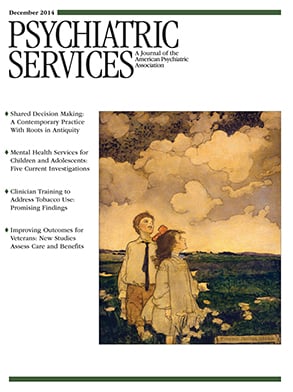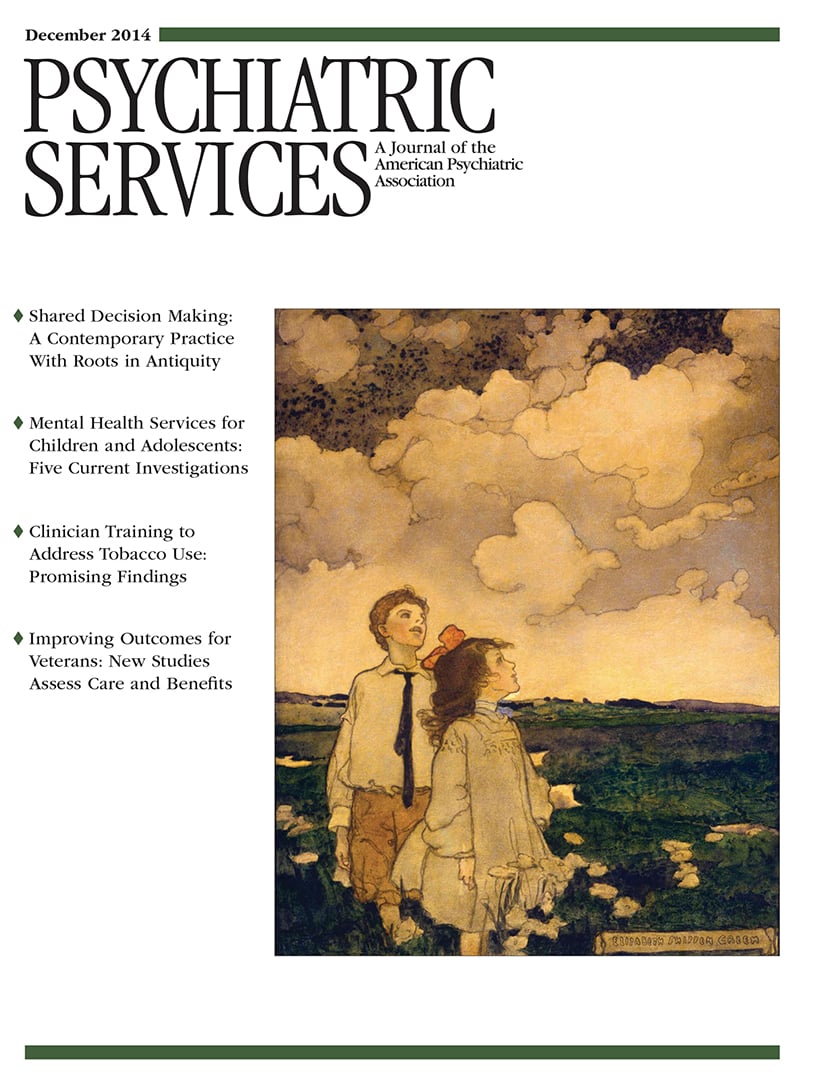Supported employment improves vocational outcomes (
1), but its effects on nonvocational functioning and social functioning are less clear (
2,
3). Finding employment is often associated with better quality of life, improved self-esteem, and fewer disability claims (
3–
5). Individuals in supported employment programs who find work report better social integration, but some also report stress and conflicts with colleagues or employers (
6).
Whether employment has positive or negative effects likely depends on the workplace environment. Work-related discrimination is a common experience for people with mental illness (
7), and many perceive stigma as a potential threat that exceeds their coping resources, resulting in stigma-related stress (
8). People with mental illness often internalize negative views about mental illness, resulting in self-stigma, which is associated with giving up life goals and with demoralization. Cross-sectional data suggest that empowerment, the conceptual opposite of self-stigma, is associated with lower levels of experienced discrimination across various life domains (
9). General social support may mediate the relationship between employment and better quality of life (
10).
However, the impact of perceived work-related discrimination on self-stigma and stigma-related stress during supported employment remains unknown. In this study, we tested the hypothesis that among participants who found work in a supported employment program, only those who did not experience work-related discrimination would have lower levels of self-stigma and stigma stress after one year as compared with those who did not find employment.
Methods
A total of 116 participants (59 women) with a mean±SD age of 41±10 were recruited in the region of Zürich, Switzerland, for a study that compared three conditions with varying intensity of job coach support for finding employment. The level of intensity of support was referred to as the “placement budget.” Details of study design and recruitment are reported elsewhere (
11,
12). Thirty-nine participants received supported employment with a placement budget of 25 hours, 38 with a budget of 40 hours, and 39 with a budget of 55 hours. After finding a job, all participants received unlimited job coach support for up to two years without regard to the placement budget. The study was approved by the regional ethics committee of Zürich. After the study was described to participants, they provided written informed consent.
Self-stigma was measured at baseline and at one-year follow-up by the 29-item Internalized Stigma of Mental Illness scale (
13). As in previous studies (
13), because of the low internal consistency of the stigma resistance subscale (Cronbach’s α=.49 in our study), its five items were not included in the total score (α=.92 at baseline and .94 at follow-up). The cognitive appraisal of mental illness stigma as a stressor was assessed with a previously validated measure (
8); four items assessed the primary appraisal of stigma as being harmful (α=.93 at baseline and follow-up), and four assessed the secondary appraisal of perceived resources to cope with stigma (α=.85 and .90). A single stress appraisal score was computed by subtracting perceived coping resources from perceived harm; higher difference scores indicate more stigma stress (
8). These measures were administered at baseline and again at one-year follow-up.
Work-related experiences of discrimination during the past year were measured by five items that were compiled on the basis of feedback from mental health service users. The measure was completed at follow-up by participants who had worked at least for one day during the past year. [The five-item measure is available from the first author on request.] Participants used a scale from 1, not at all, to 7, completely, to indicate whether, because of their mental illness, they had been discriminated against or experienced disadvantages at work, had been treated in an unfriendly manner by supervisors or colleagues, had been ridiculed by supervisors or colleagues, had experienced difficulties keeping a job, or had experienced difficulties finding a job. The five-item measure showed good internal consistency (α=.80).
We used t tests for dependent samples to assess change in stigma variables between baseline and follow-up. To examine predictors of change in stigma variables while controlling for sociodemographic factors and placement budget condition, we computed four random-coefficient models, with self-stigma, perceived stigma-related harm, perceived coping resources, and stigma stress as dependent variables and with group (no employment, employment with discrimination, and employment without discrimination) as predictor variables. The models adjusted for baseline values of dependent variables. Use of the random coefficient implies that intercepts are allowed to vary randomly among individuals (
14).
Results
Nearly one-third (N=30) of the 96 participants who were assessed at the one-year follow-up did not find employment. Among the 66 who had worked at least for one day, about two-thirds (N=41) had worked in competitive employment, one-sixth (N=11) had worked at different times in competitive or sheltered employment, and about another sixth (N=14) had worked in sheltered employment only. For the entire sample, the mean score for experienced discrimination was 2.0±1.2. Information on experienced discrimination was missing for three participants. Of the 66 participants who had worked, more than one-third (N=25) reported no work-related discrimination in the past year (they answered “not at all” to all five items on the experienced discrimination scale, resulting in a mean score of 1.0); more than half (N=38) reported at least some experiences of discrimination (mean score >1.0). Thus we compared three groups at follow-up, independent of placement budget conditions: no employment (N=30), employment without experienced discrimination (N=25), and employment with experienced discrimination (N=38).
Self-stigma, appraisal of stigma as harmful, and stigma stress decreased significantly among the individuals employed in the past year who did not experience work-related discrimination (
Table 1). Self-stigma levels did not change significantly among individuals without employment in the past year and among those with employment who had experienced work-related discrimination. Perceived coping resources did not change significantly in any group (the group without employment reported lower coping resources at follow-up, but the change was not significant [p=.08]).
In random-coefficient models (
Table 2), lower levels of self-stigma, of stigma stress, and of appraisal of stigma as harmful at follow-up were predicted only by having been employed with no experienced discrimination. A placement budget of 40 hours (compared with 55) was related to an increase in perceived coping resources. Older age was associated with a reduced perception of stigma as harmful.
Discussion
Only individuals who found employment and did not experience work-related discrimination appeared to have significantly better outcomes in terms of self-stigma and stigma stress than those who remained unemployed. On the positive side, finding work during supported employment did not seem to increase self-stigma or stigma stress even when it brought participants into stigmatizing environments.
Several limitations need to be considered. First, all participants received supported employment, and therefore we could not assess intervention effects—only effects of finding work during supported employment. Second, depressive symptoms could have influenced participants’ reports of discrimination and the stigma measures and were not controlled for in our analyses. Third, the exact source, timing, and type of experienced discrimination were not assessed, and the small size of the subgroups of participants with competitive employment and those with sheltered employment did not permit statistical comparisons. Fourth, qualitative studies are necessary to better understand participants’ experiences (
6).
Conclusions
Despite these limitations, we found preliminary evidence that experienced discrimination may determine whether finding employment has beneficial effects in terms of coping with and internalizing stigma. Supported employment could thus usefully be combined with interventions that either reduce stigmatizing attitudes in workplace environments (
7) or help individuals to negotiate difficult choices, such as disclosure versus nondisclosure, to alleviate the impact of stigma and stigma stress (
15).
Acknowledgments and disclosures
This study was supported by the Zürich Impulse Program for the Sustainable Development of Mental Health Services (zinep.ch).
The authors report no competing interests.

